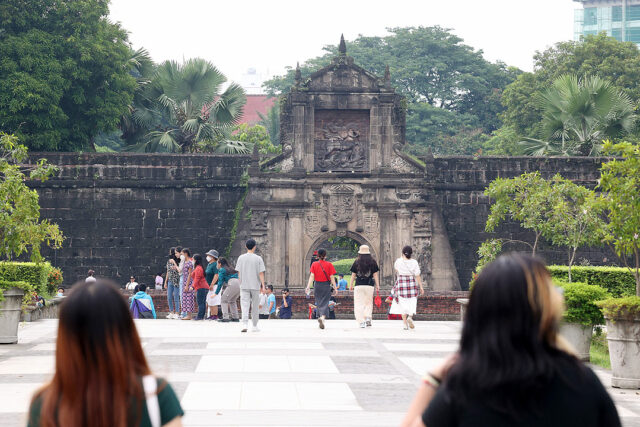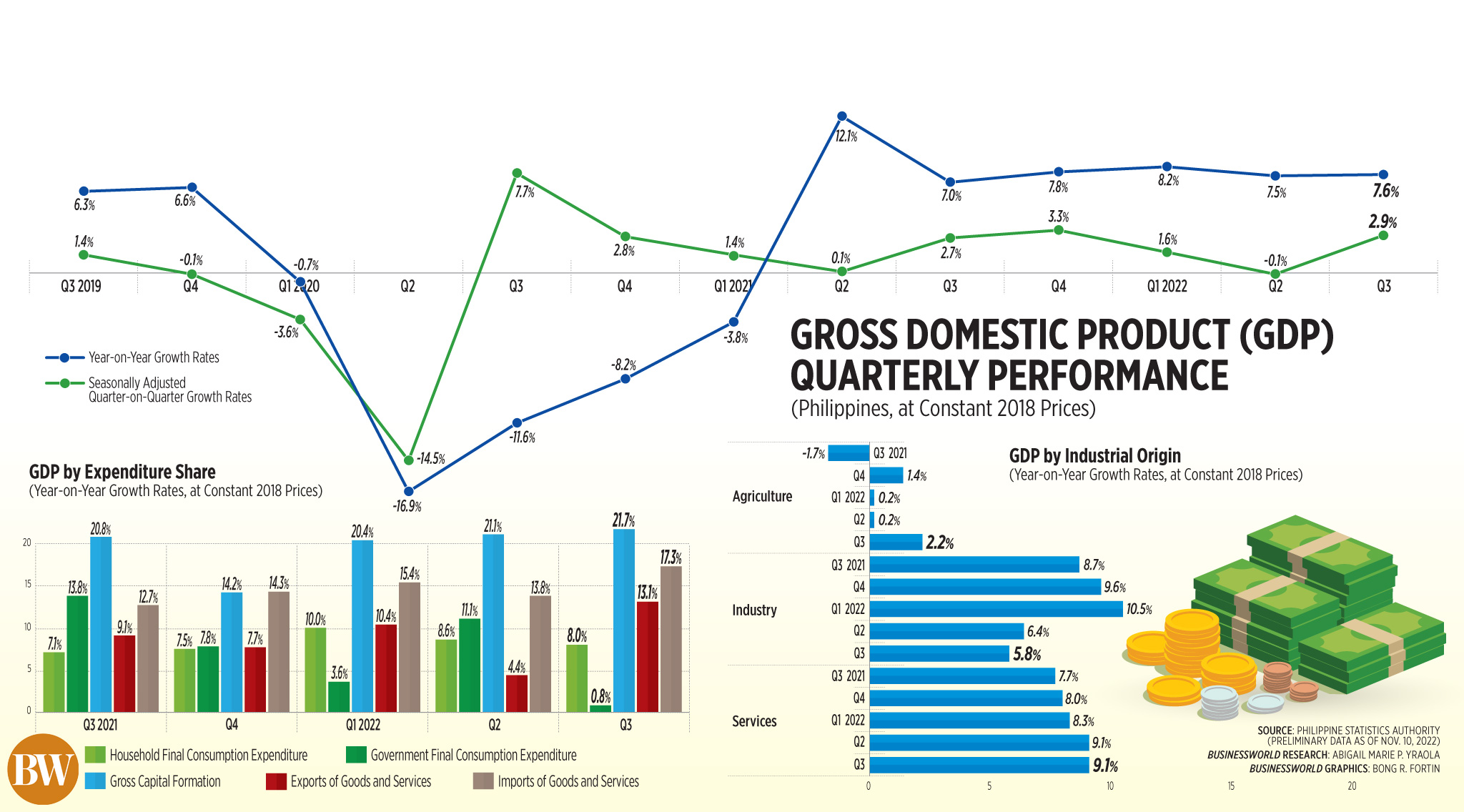
By Luisa Maria Jacinta C. Jocson, Reporter
THE PHILIPPINE ECONOMY expanded faster than expected pace in the third quarter, putting it on track to beat the government’s full-year target, but faces headwinds from soaring inflation and rising interest rates.
Preliminary data from the Philippine Statistics Authority (PSA) showed the gross domestic product (GDP) grew by 7.6% in July to September, slightly faster than the revised 7.5% growth in the second quarter and 7% a year earlier.
The latest growth was higher than the 6.1% median forecast in a BusinessWorld poll last week.
For the first nine months of the year, GDP growth averaged 7.7%.
Socioeconomic Planning Secretary Arsenio M. Balisacan was surprised by the high growth.
“Despite the surge in consumer prices in recent months and also the increases in interest rates, the performance of the economy could have been higher in the third quarter, if not for those developments,” he told a news briefing. “Nonetheless, the 7.7% [nine-month] performance is very respectable.”
The Philippines’ GDP growth of 7.6% was the second highest in Southeast Asia in the third quarter, behind Vietnam’s 13.7%.
“The better-than-expected third-quarter economic performance reflects the many good economic news lately… Overall, the recovery is gaining strong traction,” Finance Secretary Benjamin E. Diokno told reporters in a Viber message.
To achieve the government’s 6.5-7.5% full-year target, Mr. Balisacan said the economy would only need to grow by 3.3-6.9% in the fourth quarter.
“It does appear that achieving our target this year is not a problem, we only require 3.3% growth to a achieve the low-end of the range. Fourth quarter is usually the highest growth rate in a year, so I don’t expect that. We may even grow higher than what is targeted for the entire year,” Mr. Balisacan said.
On a seasonally adjusted quarterly basis, GDP expanded by 2.9% versus a 0.1% decline in the second quarter, which Mr. Balisacan said reflected the economy’s “solid posture against current domestic and external risks.”
HIGH INFLATION
“While these developments are remarkable, I want to underscore that our nation still faces a considerable burden in the form of high inflation due to heightened external risks and the brunt of recent typhoons,” he said.
Inflation remained elevated in the third quarter, surging to 6.9% in September. September also marked the sixth straight month that inflation breached the Bangko Sentral ng Pilipinas’ (BSP) 2-4% target this year.
For the nine-month period, inflation averaged 5.1%.
To tame inflation, the BSP has raised its benchmark policy rates by 225 basis points (bps) this year.
During the quarter, the country was also struck by a number of storms, including Typhoon Karding which resulted in P3.12 billion in agricultural damage.
“If not for those increases in consumer prices, one would have expected higher economic performance. Remember that globally, high inflation is a major problem… Our greater challenge is addressing quickly the adverse effects of natural disasters like the recent typhoons in the span of a few months,” Mr. Balisacan said.
STRONG CONSUMPTION
On the demand side, household consumption and investment were the main drivers of growth in the third quarter. So-called revenge spending may have contributed to the strong household consumption, as Filipinos moved more freely.
Mr. Balisacan said rapid growth came from spending in restaurants, travel, and tourism.
“This turnout signifies that Filipino families are close to returning to pre-pandemic life, as more people visit restaurants and hotels and engage in recreational activities within the country,” he said.
Household consumption rose 8% year on year, slower than by 8.6% in the second quarter but quicker than 7.1% a year earlier.
Quarter on quarter, household final consumption grew by 5.7%.
“This economic performance largely benefited from the further easing of mobility, including the resumption of face-to-face classes, which boosted consumption among Filipinos,” Mr. Balisacan said. “The relaxation of border restrictions and more simplified travel protocols also supported the growth of local tourism and other sectors severely affected by the pandemic, leading to economic expansion in the third quarter.”
Gross capital formation, the investment component of the economy, jumped to 21.7% in the third quarter from 20.8% last year. It was also slightly faster than the 21.1% in the previous quarter.
However, government expenditure growth eased to 0.8% in July to September from 13.8% a year ago and 11.1% a quarter earlier.
Mr. Balisacan said the slower government spending was “quite surprising” in an election year, adding the government might have frontloaded spending in the first half.
PSA data also showed export of goods and services expanded by 13.1% in the third quarter, from 9.1% a year ago and 4.4% in the second quarter.
Imports likewise grew by 17.3%, better than 12.7% a year earlier and 13.8% in the previous quarter.
“The imports of services had the largest expansion at 55.2% in the third quarter. This was followed by export of services at 32.5%, construction at 11.8% and durable equipment at 11.6%,” National Statistician Claire Dennis S. Mapa said.
On the production side, all sectors sustained annual growth — services by 9.1%, industry by 5.8%, and agriculture by 2.2%.
Quarter on quarter, services grew by 4.2%, agriculture by 1.6%, and industry by 0.8%.
The service sector had the biggest contribution to GDP growth at 5.8 percentage points, followed by industry at 1.6 points and agriculture at 0.2 point, Mr. Mapa said.
Net primary income from the rest of the world was 94.6%, surpassing the contraction of 52.4% in the previous year and better than 65.3% in the second quarter.
Gross national income — the sum of the nation’s GDP and net income received from overseas — rose by 10.5% from 2.8% a year ago and the 9.3% in the previous quarter.
OUTLOOK
The better-than-expected third-quarter growth gives the BSP room to further tighten monetary policy to address rising inflation.
“With the holidays fast approaching, we can expect the growth momentum to remain intact with household spending likely supporting overall economic activity for the first holiday without mobility restrictions,” ING Bank N.V. Manila Senior Economist Nicholas Antonio T. Mapa said. “With growth resilient, we expect the BSP to remain hawkish, with the central bank likely pushing the policy rate to 5.5% by yearend,”
In a separate report, ANZ Research said the monetary tightening cycle “may need to be deeper than currently anticipated.”
The Monetary Board is set to raise key interest rates by 75 basis points (bps) at its Nov. 17 meeting, to match the US Fed’s latest tightening.
“The fiery print for the third quarter surpassed comfortably even the most optimistic forecast. Needless to say, we’ve got no choice now but to upgrade our below-consensus 5.6% full-year GDP growth forecast for 2022,” Pantheon Chief Emerging Asia Economist Miguel Chanco said in a note.
On the other hand, Makoto Tsuchiya, assistant economist at Oxford Economics, said the economy would likely decelerate in the coming quarters.
“Inflation, which we see peaking in the fourth quarter, will continue to weigh on household spending. Moreover, growing external headwinds, including elevated commodity prices, tighter financial conditions globally, a recession in the advanced economies, and China slowdown, will reduce demand for Philippines’ goods exports,” Mr. Tsuchiya said in a note.
In a report, Moody’s Analytics said the economy is on track to grow over 7% by yearend, but high inflation will likely continue into early 2023.
“The rest of 2022 and early 2023 will be bumpier as the country battles with inflation, rockier global economic condition, and rising interest rates. Higher inflation and interest rates will squeeze household spending and business investment,” Moody’s Analytics said.
Q3 GDP surprises with 7.6% growth
Source: Bantay Radio

0 Comments